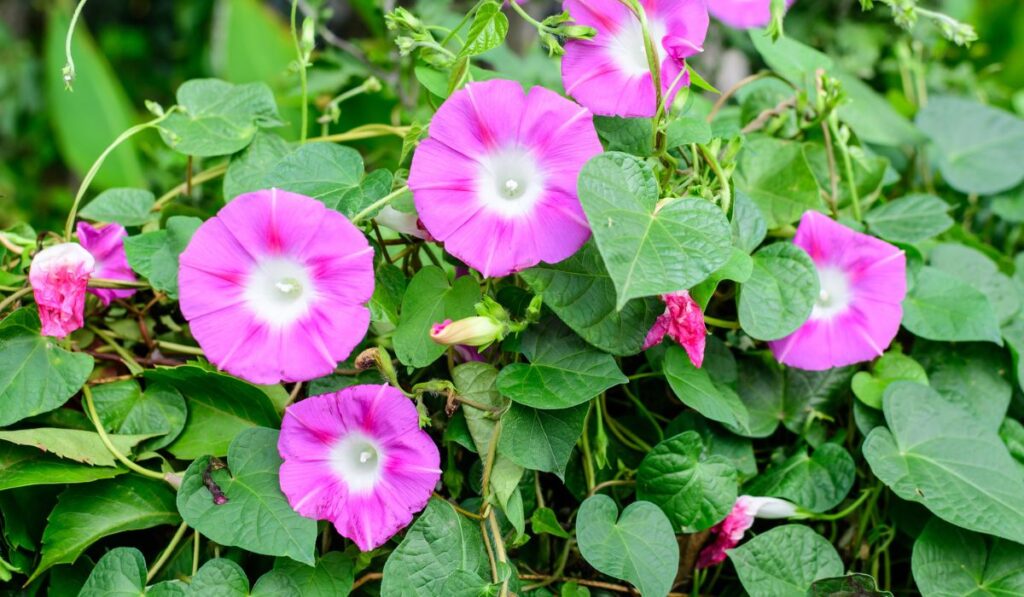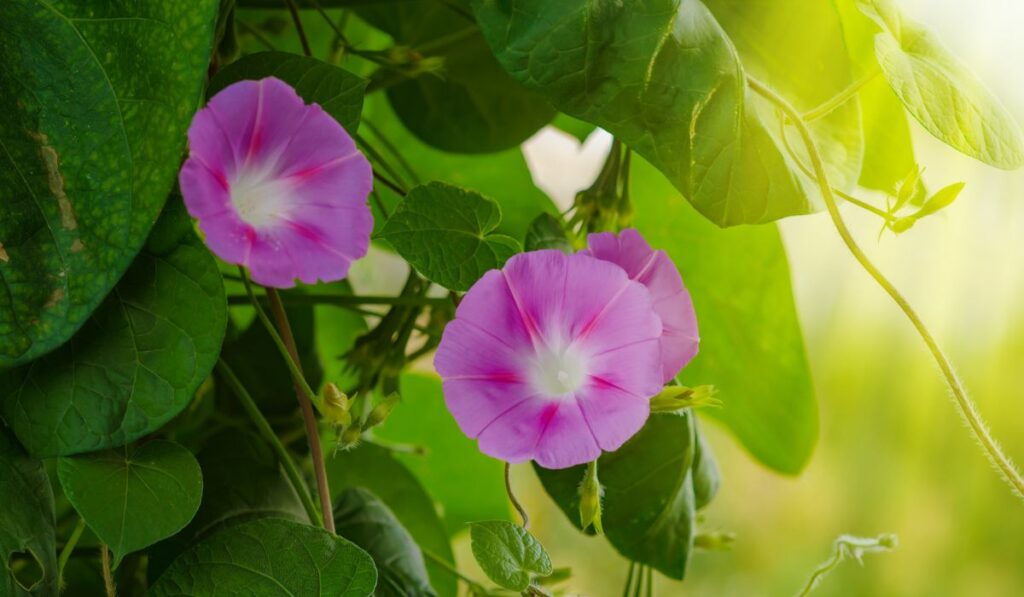With a unique name that depicts their flowering cycle of opening in the morning, morning glories make a great, colorful and tall addition to any garden space. They are easy to care for, beautiful, and provide food for insects and birds. It’s no wonder they are such a popular plant to grow.
Plant morning glories between spring and summer with something the vines can climb, like a fence. They bloom from June to October, reseeding each year. The seeds require an overnight soak and full sun, and are poisonous to people and pets. The flowers attract hummingbirds, butterflies, and bees.
Morning glories not only come in a range of colors and sizes, but they are extremely hardy and can grow in almost any full sun location. With the option to create an entire wall, fence, or arch covered in morning glories, they are a versatile plant that can surely make any garden become a vibrant place to enjoy.
What Are the Best Months for Planting Morning Glories?

Morning glories are best planted in early spring to summer. You can start them indoors about four to six weeks before the last frost in spring, and then transplant them outdoors.
Sowing them directly into the ground is also easy to do, but will need to be done once the last spring frost is over. They are hardy plants, but the cold will kill them, so it’s important to sow them once the ground is warm: roughly at 64 F or 18 C.
How to Plant Morning Glories
Morning glories are fairly easy to plant from seed. The first thing you should do is soak them overnight in some water or “nick” the seed. Opening the hard shell around the seed helps them germinate.
Because morning glories are sensitive to cool temperatures, you want to plant them once the ground is warmed and after the first frost. Otherwise, you risk killing the seeds. They require full sun but can survive in part shade, though this will mean their blooms won’t be as big or plentiful. Morning glories also need some shelter from strong, drying winds.
You will want to make sure the area you choose to plant morning glories can support its rapid growth as well as its height of 12 feet. Because it’s a vine plant, you need to provide it something to climb on, like a fence, lattice, or trellis. Alternatively, you can plant morning glories in a hanging basket and simply let the vines overflow.
When planting, space the seeds roughly six inches apart and cover them with a quarter inch of soil. After they’re planted, water them thoroughly so the ground is nice and wet to encourage germination. Seedlings usually begin to appear after about a week, so make sure the ground is constantly moist, but not wet.
If you are planting from seed rather than transplanted seedlings, add some peat or disintegrating pots that can be directly planted into the soil to ease the stress from establishing roots. After you have planted, use a balanced liquid fertilizer (on Amazon), but don’t over-fertilize: this will cause more foliage will grow instead of flowers.
Do Morning Glories Bloom Year-Round?
Typically, morning glories bloom from June until October, but it also depends on your location. If you have warmer seasons than you might get a longer bloom period, or if the last frost comes in late or early in the fall, then the flowering duration will be shorter.
Morning glories have a unique way of flowering. They open in the morning and close in the afternoon. You might think that they look dead in the evening as opposed to how they looked in the morning, but they are just going through their sunlight cycle to get the best rays of the day.
While they are annuals, with each bloom they reseed to return next year. If you don’t want the morning glories to reseed, simply pinch off the flower before it can become a seedpod.
Do Morning Glories Attract Hummingbirds?
Not only are morning glories beautiful plants to have in a garden, but they attract both hummingbirds and butterflies with their nectar-rich flowers. The slight fragrance attracts nectar feeding insects and hummingbirds and the funnel shape of the flower makes it easy for them to eat.
Morning glories also attract endangered species like bees, making them a great addition to a garden to help our fragile ecosystem.
How to Care for Morning Glories

Here’s how to incorporate morning glories into your garden and create an environment in which they can thrive.
Words of Caution
While morning glories can attract beneficial insects and bird activity to your garden, it’s important to remember that they are toxic to both people and pets, especially their seeds. Morning glories contain a chemical that is similar to LSD, which can cause diarrhea and hallucinations that require medical care.
When planting, it’s vital to remember to keep the seeds away from children and pets, especially in a yard with free-roaming animals that could potentially dig them up before they sprout.
Using Morning Glories
Because morning glories are climbing plants, they are great for accenting doors, pergolas, fences, or arches in a garden. They provide shade with their extensive foliage and the flowers offer an abundance of color. They also do well in poor soil, making them favored flowers for those hard-to-plant spaces like garden edging.
Many people even make a living wall or fence of morning glories using wire for the vines to climb up. If climbing up isn’t your intended goal, they do really well in hanging baskets as their vines just spill over the edge of the basket and give a full, long look.
Growing Tips
- Propagation: To propagate, simply take a softwood cutting with a few leaves on it and place it in some water to begin rooting. Alternatively, you can harvest seeds in the fall for next year.
- Fertilizer: It’s important to fertilize at the beginning of a planting cycle, but it’s not necessary to do so after that initial dosage. If you still want to, monthly fertilization can help, but be sure not to over- fertilize, as that can cut down on the amount of flowers you get.
- Mulch: Mulch can help the soil retain its moisture and stop weeds, which is important while the plant is young.
- Low Maintenance: Water sparingly once the plants are mature. There is no need to prune or deadhead because the flowers reseed before they die, allowing them to come back next year.
Dealing with Pests
While morning glories are a hardy plant and not typically bothered by pests and disease, they are subject to pests that enjoy feeding on them and disease that can affect their leaves.
Deer
Deer love eating morning glories, so to stop them from chowing down, you can purchase deer repellent (on Amazon).
Aphids
You’ll know you have aphids when you spot misshapen or yellowing leaves. They can become sticky, or you might notice a black sooty mold growing on the foliage. To stop aphids, apply insecticidal soap (on Amazon) to the leaves until they are gone.
Leaf Miners
Leaf miners are an insect that cause blisters on foliage. They can be stopped by removing the infected leaves, though prevention is key, which is done by tilling the soil early in the season and rotating plantings.
Rust
Rust is a fungus that causes orange pustules to form on the underside of leaves and stems. To stop rust, you’ll need to remove the infected leaves and plant debris, disinfect tools to prevent it from spreading, and provide good air circulation and weeding.
Leaf Spot
Leaf spot is a fungus that gets its name from its appearance. Large spots on leaves that look fuzzy or with pustules on the lesions. To get rid of this fungus, you need to remove the infected leaves, weed and remove debris regularly, disinfect tools, and provide good air circulation.
Note that it is important to never compost infected leaves, as this can then encourage the fungus to grow in compost and spread further.
